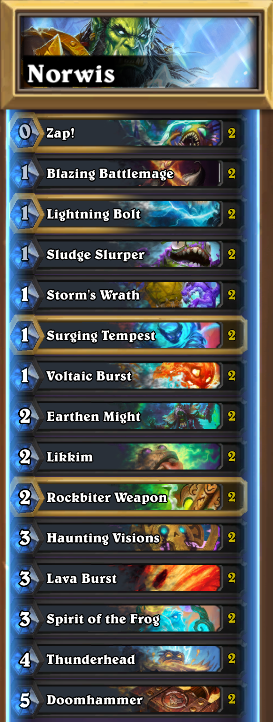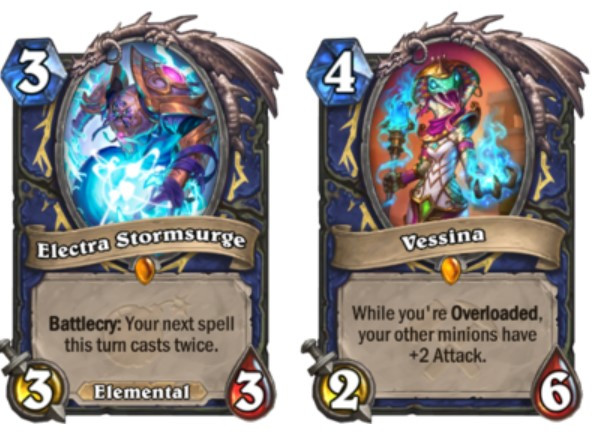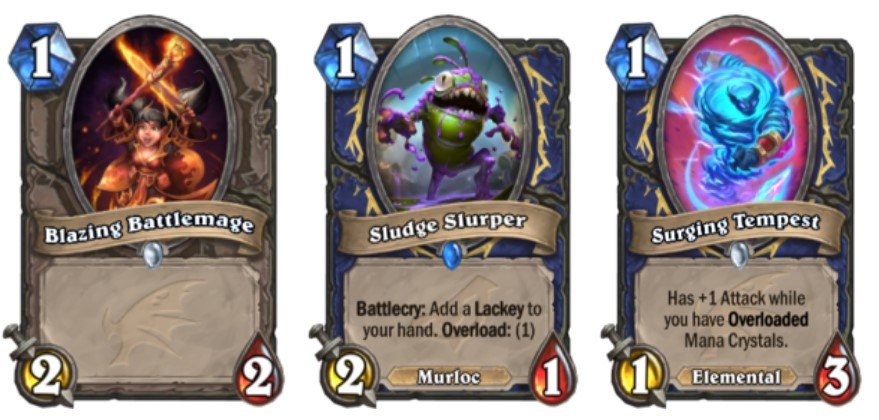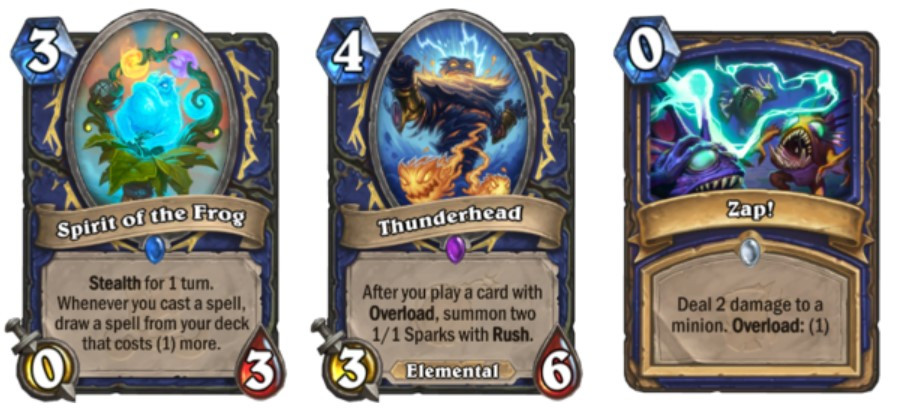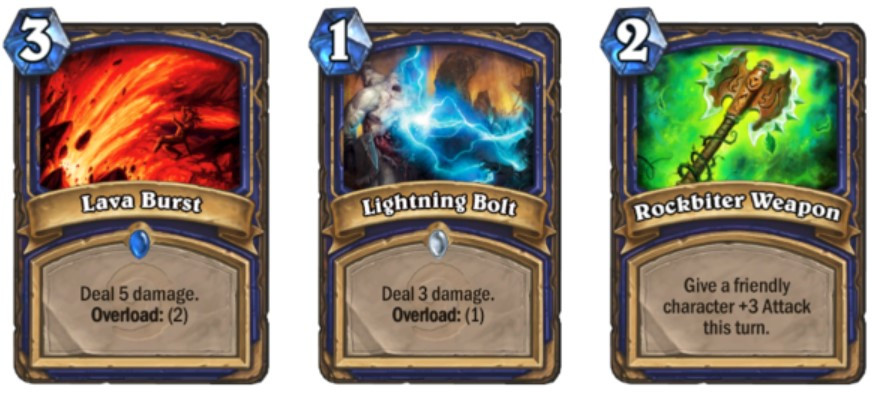Aggro Shaman is one of the oldest archetypes in Hearthstone. Recently, the deck regained a lot of popularity after Norwis climbed to the top of the standard ranked ladder with the deck.
Today, Norwis is here to share everything you need to know and more about Aggro Shaman.
Norwis consistently reaches rank #1 legend in both the standard and Wild ranked ladders and is because of this in a unique position to share his perspective on the deck.
This month, Norwis used this deck to climb to rank #1 legend. To this day Norwis holds the #1 spot on the ladder, after going uncontested for over a more than three day period. Norwis expects his current placement on the ranked ladder to qualify him to the Master’s Tour Sweden event later this year, at DreamHack Summer in Jönköping.
🤡Back on one, job is done🤡
— Štěpán Šimek (@Norwis135) March 24, 2020
...and now seriously, after long testing I finally made the best version of Aggro Shaman (had 10/0 winstreak from 4 to legend 1 with this version), tier 1 deck worth just 4120 dust, just try it ;) pic.twitter.com/CD9nk9tRGE
Norwis’ Aggro Shaman build
To play Norwis’ Aggro Shaman build, copy the link below and enter your collection.
AAECAZnDAwAP7wHgAvkD4Aaw8AL28AKP+wKc/wKKhQOMhQP2igPGmQO1rQO2rQP5rgMA
One of the major upsides of this specific deck is the low cost to create it.
The deck utilizes a total of 6 Epic rarity cards and no legendary cards. Because of this, the total cost of the deck is only 4120 dust, making it one of the cheapest competitive decks available today.
Norwis adds that this deck is more difficult to learn than most aggressive style decks in Hearthstone’s history, however, Norwis expects the average player will need around 20 or so games to figure out how the deck should be played, before their win rate skyrockets.
As proven, the deck is capable of reaching the very top of the ladder and should be a deck included in your arsenal.
There are several versions of the Aggro Shaman deck Norwis currently going around.
The deck by Norwis uses Haunting Visions as its staple card. The Haunting Visions replace Vessina and Electra Stormsurge from the most popular version of Aggro Shaman. There are several reasons Norwis replaced the two cards by Haunting Visions.
Vessina & Electra Stormrage
Norwis argues that if you can play Vessina safely, you have won the game already. Electra Stormsurge, on the other hand, is even worse in the majority of games. There are a few reasons for this, according to Norwis. If you play Electra Stormsurge on the curve, the card is often too weak for what you need the minion to do.
Later on in the game, the best use of Electra Stormsurge is combining it with Lava Burst. However, while this may win some games, it hurts you more often than it helps you out. And, in the cases you don’t get to combine the two for the best-case scenario, the card is simply not worth using in your damage combo.
There are some tech cards Norwis uses and recommends you to try out too. The main tech card he used on his climb to the top is changing Blazing Battlemage with the card Earth Shock. Earth Shock is the perfect tool to get around taunt minions or to silence a dangerous effect which may allow the game to extend.
The Key Matchups
There are many interesting matchups for the Aggro Shaman deck to talk about. Here is Norwis’ take on each of the current popular archetypes you may face on the ladder.
Warrior, Rogue, and Mage
Warrior (40-25%):
Warrior is by far the worst matchup for the Aggro Shaman deck. Our win rate against this deck ranges anywhere from 40% against Galakrond Warrior to 25% against the Highlander Warrior archetype. In a tournament setting, this is by far the most common class to ban, and it's recommended you do the same. The reason this matchup is so tough to win is the amount of removal and health generation tools Warrior has access to within the class.
Rogue (50-55%):
Rogue is the second-worst class to face for the Aggro Shaman archetype. While this matchup is only close to 50% for both Galakrond Rogue and Highlander Rogue, the Rogue decks still have good coverage against the other decks you may bring to a tournament.
Mage (60-65%):
One of our best matchups is the popular Highlander Mage archetype. It is the only popular archetype currently in the Hearthstone meta, and as such we are often happy to see this class as our opponent.
Warlock & Hunter
Warlock (60%):
The Warlock class is one of our more interesting matchups. Due to its two drastically different strategies in Galakrond Warlock and Zoo Warlock, it can be difficult to mulligan correctly. If you assume your opponent plays the Zoo Warlock archetype, you can choose to keep the card Likkim to improve your matchup. The weapon is a great tool to fight for control of the board in the early turns, a vital part of defeating the Zoo Warlock deck.
Galakrond Warlock, on the other hand, requires you to save up your burst cards as long as possible. The reason for this is the large number of healing tools available to the deck. Cards such as Alexstrasza, Sacrificial Pact, Zilliax or even Zephyrs the Great can cause us to run out of damage before the game is secured.
Hunter (65-55%):
The Hunter class has a total of three archetypes. The most common two, Dragon Hunter and Highlander Hunter, are great matchups for our Aggro Shaman deck. The game is played out quite straight forward as you compete for control of the board early on and finish them off with powerful Shaman spells.
The final archetype, Face Hunter, is far less common than most. However, it is also a good matchup for our deck. Against Face Hunter, in particular, it is more important to preserve your health total early on if possible. Racing the Face Hunter deck is a possible strategy.
However, this strategy is more volatile than most players are comfortable with.
Norwis recommends keeping Likkim against all Hunter archetypes in addition to the normal mulligan advice found below. Our win rate against Hunter ranges from 65% against Dragon Hunter to 55% against Highlander Hunter.
Druid, Shaman, Priest, & Paladin
Druid (60-55%):
There are two popular archetypes of Druid going around currently. Both Quest Druid (60%) and Embiggen Druid (55%) are favourable matchups for us, with clear weakness in the early turns. The key to success against Druid is to fill the board as quickly as possible. Use your minions in the early turns while Druid is weak to take the lead and close out the game.
Shaman (50%):
The Shaman class is currently only the mirror match. The mirror match, like most in Hearthstone, often snowballs quickly into one player’s favour due to the strength of the deck's early turns.
Priest (60%):
Priest currently in the Standard format is only differing builds of the Resurrect Priest build. Our overall matchup against this archetype is quite good at around 60%. Against classes such as Mech Paladin, Mage and Priest Norwis recommends switching to the Earth Shock builds of the deck.
Paladin (60-45%):
The final class is Paladin. The deck has two vastly different archetypes. The first is the Shirvallah, the Tiger builds, which we are favoured against by about 60%. On the other hand, Mech Paladin is likely our most difficult matchup of them all, besides Warrior, at only around 45%.
The Mulligan for Aggro Shaman
There are several cards we keep no matter what matchup. In every matchup, finding a 1-cost minion is key. The best one-cost minion to find is Surging Tempest. However, Sludge Slurper and Blazing Battlemage are also always worth keeping.
The other tools are part of our combo, Spirit of the Frog, Thunderhead and a copy of Zap!. Each part of our combo we only want one copy off usually. However, if you already found a Thunderhead or a Spirit of the Frog, you can consider holding onto two copies of Zap! to improve your swing-turn further.
The more situational cards include Earthen Might, a card we only keep if you already found a copy of Surging Tempest or Blazing Battlemage alongside it. Or tools such as Storm Wrath you can consider if you find two one-cost minions or a one-cost minion alongside Voltaic Burst. If this situation occurs, try and go all-in as soon as possible to take control of the board right away.
Likkim is often kept against the matchups mentioned above, such as Zoo Warlock or Hunter. However, it is also worth keeping if you are facing off against a class such as Mech Paladin or the Shaman mirror match under some circumstances. The most common situations to keep Likkim are when you already have any copy of Thunderhead, Spirit of the Frog, Sludge Slurper or Voltaic Burst in your hand alongside it.
How to play the deck
There are two main ways to win with the Aggro Shaman deck.
The first is to play your combo on the curve. The ideal situation for the deck is to play a one-cost minion on turn one, followed by Likkim on two, Spirit of the Frog on 3 with Thunderhead and spells such as Zap! and Coin on turn four. If you manage to pull this off on the curve, you simply can’t lose.
However, you often can’t pull off the dream, and you shouldn’t rely on it. More commonly you miss one or more parts of the combo, or you simply go first in a game causing you not to have access to The Coin. Often this causes you to delay going off with Spirit of the Frog and Thunderhead. Most of the time, this only delays you by one or so turn before you can draw your damage spells.
If you happen to miss out on Thunderhead, you should choose to delay the use of Spirit of the Frog until far later in the game. The Frog is vital to you finding enough damage spells later on in the game to defeat your opponent. Delaying playing the card until the final rounds of the game is often the best choice if you can’t find a Thunderhead to take control of the board early on.
The alternative strategy
The second strategy is more focused on taking control of the board. If you have a starting hand that can take control early on, this can certainly lead you to victory. You can choose to go for this path if you find several one-cost cards early in the game, alongside cards like Likkim, Earthen Might, and Storm Wrath. This strategy is a fairly common way to win for the deck, whenever you don’t find enough tools to take over with Thunderhead.
The second strategy uses its spells more readily to preserve control of the board and to push earlier damage compared to the combo strategy. It is important to keep in mind that this strategy is not an option against decks with strong healing tools such as Galakrond Warlock as you need to combine all your spells to defeat them from a high health point.
To play the deck optimally, you have to decide which of the two strategies is your best chance at success against your opponent. This decision is mainly influenced by your starting hand, before and after the mulligan phase of the game.
Norwis’ Tips and Tricks
1. Plan your overload tools
The Aggro Shaman deck includes many tools using the Overload effect. Managing your overload is one of the most important aspects of the Aggro Shaman deck. There are many scenarios where you want to avoid overloading. Just one example is when you have a copy of Doomhammer in your hand, which you are looking to play soon. Try and look at the number of mana you need available on your next turn, and how that impacts your decisions for this turn.
2. Using a Rockbiter Weapon as removal is OK!
A common mistake beginners make playing the Aggro Shaman deck is saving Rockbiter Weapon too long. While you often want to save Rockbiter Weapon to push a large amount of damage with Doomhammer, it isn’t the only option for the card. Taking control early on of the board, by clearing your opponent's minion with a Rockbiter weapon can improve your chances of winning far more than gaining the extra three damage from the card later on in the game.
3. Save a low-cost spell in the late-game stages
When things are looking dire, holding on to one or more low-cost spells can be your way back into the game. The way to go about this is by drawing a Spirit of the Frog and drawing into several spells to clear a threat or lethal your opponent.
4. Avoid playing minions if the board is lost
This tip is a little more specific than most. However, it is likely going to help you win a game one day. If you have lost the board later on in the game, and your opponent is at a low health-total, avoid playing minions or using your Hero Power. The reason for this is the commonly played card, Zilliax. Zilliax can only heal right away if an opposing minion is available for it to attack. Because of this, not using your hero power could give you the time to draw into the final spell needed to defeat your opponent.
5. Try not to Tilt
Seriously, Norwis warns that tilt is a big risk for this deck in particular. Due to the volatility of the deck, it can win or lose many games in a row, even if you are making the least amount of mistakes you can. Don’t give up, it will all work out in the end!
Norwis’ Guide to Aggro Shaman
You reached the end of Norwis’ guide to Aggro Shaman, for more decklists, guides or questions be sure to check out Norwis on Twitter. Writing and editing by Arend Zijdenbos.

 No ads, our video library,
No ads, our video library,

